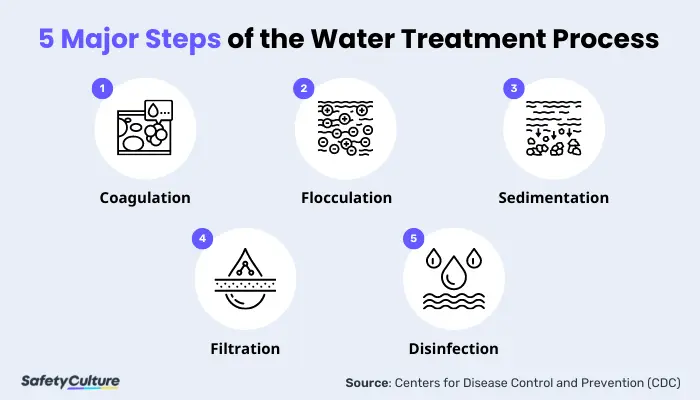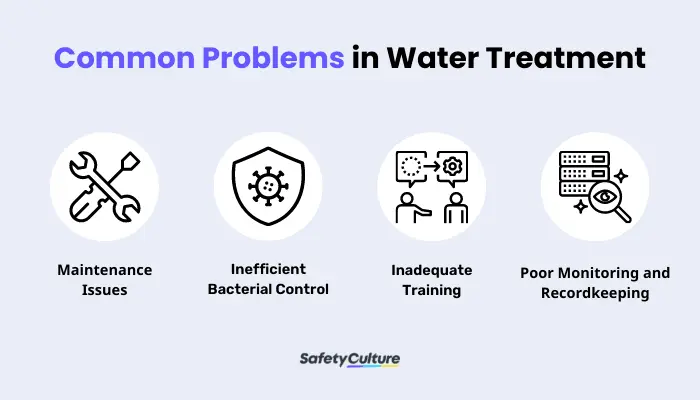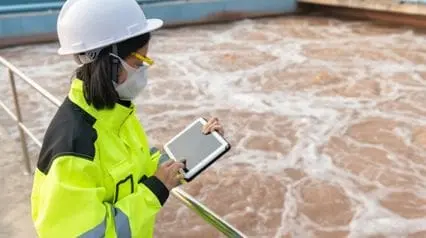What is Water Treatment?
Water treatment refers to the process of improving the quality of water with the purpose of serving an end-use. The most common end-uses include drinking water, industrial water supply, water recreation, and for replenishing environmental sources, such as rivers and lakes.
Why is Water Treatment Important?
Clean water is a basic necessity for humans. While the human population grows, the demand for water grows as well. Since water is a finite resource, used water must be treated to continuously serve end-uses. This is where the importance of water treatment systems comes in.
Water treatment helps in removing contaminants and hazardous substances from the water, making it clean and safe to drink and be used for other purposes. Unfortunately, almost 2 billion people in the world use either untreated drinking water or get water from unsafe or contaminated sources. Having systems in place to improve water quality helps intervene in these situations and prevent unsafe water-caused incidents, such as water-borne diseases and fatalities.
On the other hand, water treatment is also helpful in ensuring that water gets reintroduced back to nature’s cycle. One of the end-uses of this process is to safely return water to environmental sources like rivers, lakes, and oceans. Of course, water treatment facilities must ensure that water is free from harmful substances before doing so to avoid contamination and other environmentally disastrous issues such as water pollution.
The United States Environmental Protection Agency (EPA) sets forth guidelines for organizations for protecting the environment and human health. One of the violations that an EPA report helps keep in check regarding an organization’s compliance with environmental safety is the illegal discharge of pollutants that could end up in bodies of water. An example of this is dumping untreated and contaminated wastewater directly into the sewer system, which is a violation of the Clean Water Act.
Process
In most cases, water treatment plants are responsible for collecting, treating, and distributing supplies of water, whether for residential, commercial, or industrial uses. Globally, these facilities may follow slightly different processes in their water treatment systems. However, their methods are all based on similar stages depending on the end use they aim to achieve.
What are the 5 steps of water treatment?
According to the Centers for Disease Control and Prevention (CDC), the overall water treatment process, especially for public water systems, consists of 5 major steps:

Water Treatment Process | Source: Centers for Disease Control and Prevention (CDC)
1. Coagulation
The first step of getting water treated is through coagulation. This involves adding chemicals with a positive charge to the water which should neutralize the negative charge of dirt and other dissolved substances. Such chemicals include iron and specific types of salt.
2. Flocculation
This step refers to the process of gently mixing the water to create larger, heavier particles known as flocs. In most cases, additional chemicals are being added to the water to allow the flocs to form easily.
3. Sedimentation
Once flocs form, they settle to the bottom of the water because they are heavier. This is called sedimentation in water treatment, which is one of the processes that water treatment plants use in separating the solids, such as flocs, from the water before going to the next step.
4. Filtration
The water again goes through another process of solids separation through filtration. The separated, clear water on top now passes through filters with various pore sizes, made from different materials such as sand and gravel. Ultimately, these filters are in place to help remove dissolved particles and unwanted substances from the water.
5. Disinfection
During this step, any remaining parasites, bacteria, and viruses must be eliminated. This can be done by adding one or more chemical disinfectants to water such as chlorine or chlorine dioxide. Why do water treatment plants do this? It’s to keep water safe when traveling from the water treatment plant to homes and businesses because chemical disinfectants help eliminate the remaining unwanted microorganisms before the water reaches the intended end-use.
Create Your Own Water Treatment Inspection Checklist
Eliminate manual tasks and streamline your operations.
Get started for FREEDifferent Types and Uses
Generally, water treatment systems differ in serving specific end-uses. The 3 most common types are the following:
Household Water Treatment
According to the National Sanitation Foundation (NSF), the general kinds of systems that are used as water treatment solutions include the following:
- Point-of-use (POU) systems – water pitchers, faucet filters, and reverse osmosis (RO) systems, etc.
- Whole-house/point-of-entry (POE) systems – municipal systems, pressurized storage tanks, UV microbiological systems, water softeners, etc.
Also, home water treatment systems either use advanced water treatment or conventional septic tank systems to treat water from households.
Industrial Water Treatment
This process refers to the treatment that is performed pre- and post-industrial use. Since businesses from various industries use water differently, water treatment processes can be done before or after performing business activities to serve the intended use of water. For example, water treatment in the Food and Beverage sector under the Hospitality industry is crucial for ingredient water used in processing food. On the other hand, manufacturing plants in the Automotive industry need to reuse or dispose of wastewater, and water treatment can help in that process.
Wastewater Treatment
Wastewater refers to any used or polluted form of water, generated after different types of uses and applications. Its sources include rainwater runoff and human activities. Wastewater treatment is key to removing any contaminants and being able to convert the quality of wastewater and turn it into an effluent that can be safe to return to the water cycle.
Common Problems in Water Treatment
Communities, states, and countries know the importance of safe water for public use, but major problems in the way plants and facilities treat water can be often overlooked. Here are 4 of the most common issues encountered in the overall system of quality water treatment and in water treatment plants:

Common Problems in Water Treatment
Maintenance Issues
Water treatment technology, facilities, and systems must always be kept in check, inspected, and maintained. Otherwise, neglect of these protocols may cause serious implications for the overall quality and safety of water treatment processes. Failing to perform regular maintenance on equipment and other assets used can result in costly repairs, grave damage to systems, and compromised human safety.
Inefficient Bacterial Control
While some bacteria are essential to water treatment operations, failing to monitor and manage bacterial growth can endanger the quality of water. Hence, having a tested and proven system of bacterial control helps avoid such a risk and hamper the cycle of water treatment.
Inadequate Training
Those working in water treatment plants or facilities, such as operators and specialists, deal with complex, highly technological processes. As such, there’s a need to prevent any misunderstanding of certain aspects of work due to poor training. Compromised quality of training can affect not just the safety of workers but also the quality of the overall treatment cycle.
Poor Monitoring and Recordkeeping
Monitoring and good recordkeeping must be maintained to ensure that protocols are being followed and that there is evidence of it being so. Common problems encountered in these situations are best resolved through corrective and preventive actions that help address any gaps discovered in monitoring and recordkeeping processes. Without these protocols in place, water treatment plants may suffer from a lack of traceable data and patterns in order to benchmark their processes and discover improvement opportunities.
FAQs About Water Treatment
Treated water gets released into local waterways so that it can be used again for various purposes. These can include supplying drinking water, being used for industrial and agricultural activities, and sustaining household needs. The process of discharging or releasing treated water to different destinations can be done through a pressurized system of lifts and pipes.
The three main purposes of treating water are for water to be used again, to be safely returned back to the water cycle, and to help improve water quality. Water treatment, hence, helps solve the problem of drinking water shortage and the other needs of the global community.
Depending on the step or stage in the water treatment process, there are various chemicals being used to filter, disinfect, and desalinate water. Some of the most common ones include chlorine, chloramine, magnesium oxide, calcium hydroxide, and bromine.
A water treatment facility, also called a water treatment plant, is a destination where wastewater goes from various sources such as residences, commercial industries, and communities through sewage pipes. Typically, sewage treatment plants and systems use miles of pipes found underground for wastewater to flow through all the way to water treatment facilities or plants for processing.




